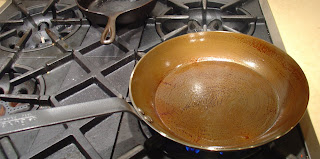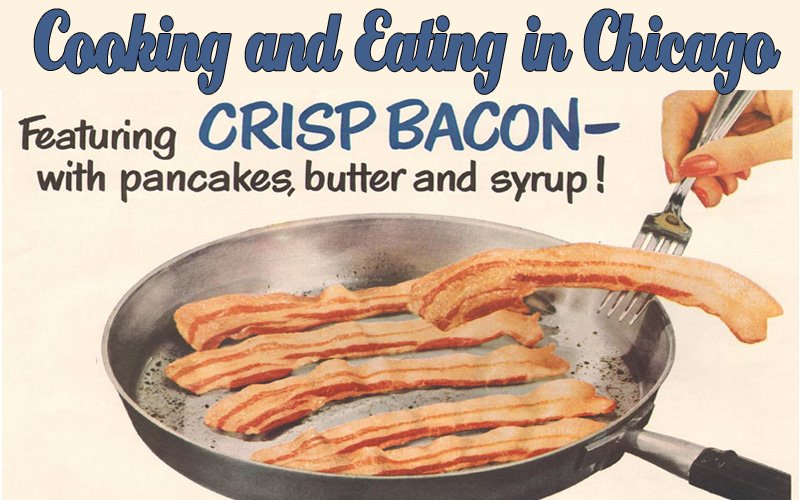
A recent search for a cheap, serviceable pickup truck led me up to Waukegan for the
Waukegan Auto Auction, and while I didn't buy a truck, I ate a dinner that was so good, I'm proclaiming the place that served it to me to be my New Favorite Restaurant.
The place is
Captain Porky's, and it's situated right on the border of
Zion and
Beach Park, Illinois, just across the street from
Illinois Beach State Park.
Moments like this generate a strange simultaneous mix of emotions. I'm literally thrilled to have discovered this place. At this very moment, as I type, I'm coming up with various excuses that will justify driving the 45 minutes each way. Oh, the thrill of anticipation...the feeling of future promise. And, yet, while I'm exhilarated at the notion of having a New Favorite, I'm also angry, frustrated, and left with a feeling of being somewhat cheated.
How could this place have been in existence for all this time and I've only now found out about it? Think of all the shrimp, crab, and lobster I could've been eating! Think of the rib tips and hot links that are gone....forever...long ago resigned to the compost heaps of history, and the many inferior meals that I wasted the time, effort, and calories on when I could've been eating at Captain Porky's.
But (sigh) all I can do, really, is look forward, towards the future.
Summer is coming. 45 minutes isn't really all that far to drive to go to the beach. And what better way to augment a trip to the beach than with wonderfully fresh fried seafood and good barbecue?
I have a feeling I'm going to be very tan this summer.
Okay, so what's so great about Captain Porky's?
Well, it's one of those places like
Calumet Fisheries or
Hagan's Fish Market where you pick the type of seafood you want and they sell it by the pound and cook it up for you on the spot. Which is cool. These places are kind of a dying breed in Chicago and they usually feature some pretty darn fresh seafood prepared by people that really appreciate fish and, therefore, respect it and know the best ways to cook it.
But Porky's goes way beyond that. I ordered a half pound of fried fresh jumbo gulf shrimp, which were hand-breaded in front of me while I watched.

These shrimp were things of beauty. Sweetness for days, a great, almost lobster-like texture, with a super-light, flavorful and greaseless batter that just barely clung to the shrimp, but still provided great crunch and a perfect toasty, slightly salty counterpoint to the succulent meat. A really nice, zippy cocktail sauce as well. It might sound like I'm exaggerating if I called these shrimp "transcendent", but I assure you, I am not exaggerating.
Have you ever tried fresh gulf shrimp? If you're not sure, then you probably haven't. 95% or more of the shrimp found in restaurants is
farmed stuff from Vietnam, which starts out bland and kind of poopy-smelling from eating homogeneous feed and being raised in crowded vats or ponds with eighty bazillion of its brothers, and it doesn't get any better once it's frozen into a block, shipped halfway across the world, and defrosted under running water in one of hundreds of Chicago restaurant basement prep kitchens that don't want to deal with the added effort or expense of sourcing fresh gulf shrimp.

People don't know any better. They think shrimp is shrimp. But, oh, that is just not so. And the irony of it is that you don't know what you're missing until you travel, maybe down to New Orleans or somewhere along the gulf coast, and someone happens to toss some fresh gulf shrimp your way. There's a world of difference. Fresh gulf shrimp have FLAVOR. They are caught from the wild, in the ocean, where their diet is varied, and this provides a rich, concentrated shrimp flavor that you just don't get from the farmed stuff. The texture is far superior as well. There's this wonderful, meatiness that's firm but yielding, a pleasant 'snap' when you bite through it, and an almost buttery richness.
I'm going on and on for a number of reasons; it's been years since I had a fresh gulf shrimp, I've never had them prepared as perfectly as the ones Dino, the owner of Captain Porky's served me tonight, and, honestly, the last thing I expected when I started trolling around the fairly depressed-looking area north of Waukegan was that I'd be eating the best shrimp ever from a styrofoam container while standing under the open hatch of the back of my car. Plus, I paid $7.50 for a half pound which was generously comprised of six or seven big shrimp.
Ok. Are you getting it now? It gets better.

They've also got an
aquarium style smoker over at Porky's, which they're firing with apple wood and lump charcoal, and they're using it to turn out ribs, chicken, pulled pork, rib tips, hot links, and whatever kinds of fish Dino feels like tossing on the smoker that day (you can see the fish at the very top of the picture to the right). When I asked for a small order of the pulled pork, he pulled out a shoulder and started working it over with a cleaver on a large butcher block, so it's not sitting in a steam table all day getting mushy.
The menu is enormous. There are thirty different options listed under "Seafood Dinner" (comes with choice of garlic potatoes or french fries, coleslaw or greens, and dinner roll or cornbread), among them crabmeat-stuffed gulf shrimp, smelt, frog legs, oysters, alligator tail, and four different kinds of crab. You can get most of those as a po' boy sandwich as well, or just order whichever type seafood you're interested in to be fried by the pound.
They had some great-looking pre-packaged items, like shrimp, crab, lobster, and conch salad, there's gumbo and clam chowder, 14 different side dishes, and they're baking their own cornbread, dinner rolls, and kaiser rolls for sandwiches. Plus the barbecue, which is authentic, legit, real-deal stuff. The hot links are made on site.
This place is like some kind of dream--or nightmare, possibly--come true. How can I possibly ever try everything? I could go there twenty times and not even scratch the surface, especially because I wouldn't be able to avoid getting the hand-breaded jumbo gulf shrimp every. single. damn. time.

But here's the real kicker; Dino, the owner, is a bigtime foodie from Greece whose family still owns and maintains an olive grove there. Once I expressed an interest and started taking pictures, he really warmed up, pulling out a giant
demijohn of green-gold olive oil from under a table for me to sample. He poured a little cupful, broke off a chunk of dinner roll and dunked it in, soaking it, and then brought it up toward my mouth, motioning for me to taste his family's oil.
Not surprisingly, it was fantastic.
Then he pulled a plastic-wrapped lump from a display cooler cluttered with chunks of vacuum-packed smoked fish, duck eggs, and other, less recognizable stuff and started unwrapping it, describing it as "homemade parmesan". It was grainy, aged maybe a year, quite salty with a little gaminess, more like a pecorino than a parmesan, so I asked if it was sheep's milk. "No," he replied, smiling proudly, "goats' milk. From my herd."
If this guy was anywhere near the city, he'd be heralded as a genius and the place would be mobbed every day, even if he charged double his current prices. How 'bout a lobster roll for seven bucks? Or a softshell crab po' boy for eight?
Here's the rub; the place, I fear, is about to get very, very busy. Dino told me that he's going to be on the
Food Network show
Diners, Drive-ins, and Dives, which is
going to be filming this weekend at
The Shanty, the nearby restaurant he helps his son run. He said that the
Food Network wanted to feature both restaurants, but that he was concerned about the crush that might cause. He seemed well aware of what's been called the "
Check, Please"
effect--the phenomenon of very good restaurants suddenly getting much worse as a result of being featured on some prominent show and the subesequent flood of people that kind of publicity causes.
If anyone can manage to avoid that particular pitfall, it's Dino.
I was so enthralled with Captain Porky's that I talked it up to my buddy Mitch, and we made the trip up a mere two days after my maiden voyage. We set out fairly early with a cooler full of beers icing in the back of the car, figuring that this time we'd do it up right and take advantage of the nice weather and the nearby picnic tables.
Dino remembered me from earlier in the week, and after I introduced Mitch, he motioned for me to come in the back so he could show me his smoker. He was working on some kind of new project involving oak, salmon sides, and rib tips. He excitedly told me his plan, smiling madly, as if describing some sort of world domination plot; "You see the fat on this?", he asked, shoving a chunk of rib tip an inch from my face, "I'm gonna put the salmon on the bottom rack, and the rib tips above it, so the grease from the pork drips down, flavoring the salmon."
As I munched on the rib tip ("Try it--it's not done yet, but it's still good--you can taste the oak"), he gestured wildly, eyes bulging with intensity, as he described the evil, pork-fat-flavored smoked salmon plot he was hatching. I nodded my approval and rolled my eyes skyward, acknowledging his mad genius.
As Mitch and I ordered way too much food, the incredibly friendly and accommodating staff handed us samples of practically every item we pointed at or inquired about. I gobbled down a couple crawfish tails, a souffle cup of gumbo with rice, a chunk of smoked chicken, and some cheese that Dino quickly battered and fried as an experiment that he deemed "too salty".
After our order was placed, we made our way out to the picnic table, strategically situated near the dumpsters, and settled in. It wasn't long after we revealed the bounty within the styrofoam clamshells that Dino came out, bearing chunks of pork-fat-drizzled salmon hot from the smoker, imploring us to try it. Of course, like everything this crazy, deep-fried, wood-smoke scented Midas touches, it was fantastic.
Dino ranted a while longer about his lambs, why "all meat you buy in this country is crap", and his organic gardens, which supply 75% of the vegetables for the restaurants, while we proceeded to eat like kings, lazily taking in the sunset and the cool lake breezes. We washed down our hot links (amazingly tender, smoky, with great seasoning), St. Louis style ribs (perfect--among the best I've ever eaten), shrimp, crawfish tails, and tartar sauce-dunked fried walleye pike fillets with plastic cups of cold Leinenkugel's, slowly scarfing more than we thought we were capable of, and exchanged looks of appreciation and satiety as we wiped the grease from our lips, confident in the knowledge that we were fully immersed in the moment, enjoying some of the best food in the world.
 Dumpster-side dining at it's finest. It doesn't get any better than this.
Dumpster-side dining at it's finest. It doesn't get any better than this.It's tempting to try and frame my Captain Porky's experience within the larger context of food politics, weaving Dino's passion for provenance into a meaningful diatribe about the evils of factory farms and industrialized produce. The amazing scope of his vision--growing his own vegetables, harvesting wild mushrooms, raising his own chickens, lambs, goats, and pigs, dry-aging his own beef, making everything from wine to cheese--lends itself to the type of back-to-basics discussions of food and foodways that seem to be nearly ubiquitous lately, including right here on this blog.
But I'd rather just show up at Porky's and enjoy. It's a simple place that lends itself to simple pleasures. Perfect fried jumbo shrimp and cold beer. Really well-executed barbecue and sticky, greasy fingers. It's nice to know that Dino is behind the scenes, micro-analyzing each tiny detail in his crazy-man quest to control every aspect of the food production process and ensure that the end result is the best it can possibly be. Don't get me wrong; I do applaud this kind of thing as representative of an alternative to the mass-produced, soulless food that dominates American dining--especially at this price point.
The beauty of Porky's, though, is in its simplicity and accessibility. Those so inclined can make the pilgrimage and pick Dino's brain about seasonality and organic mulch--I guarantee he'll talk you under the table. But folks who don't know the difference between a smelt and a fish stick will appreciate this place just as much. Maybe more.
Which is, if you think about it, maybe the best possible way to change the way regular people think about food. 98% of Americans would never in a million years dream of attending a
$125 per person farm-to-table dinner in a fancy downtown restaurant, but even those who don't know or care about terms like
organic,
sustainable,
heritage, or
heirloom can wander in and appreciate the difference between a six-dollar order of Dino's rib tips or clam strips and what they're getting just about everywhere else.
Sometimes, those of us who are food-obsessed or in the industry can forget that "good" food--from a qualitative and socio-political viewpoint--doesn't have to be expensive or fancy.
Thankfully, Dino is up in there Zion, quietly (or, more likely, not-so-quietly) doing it the way he's been doing it for the last 25 years, and helping us remember that.
 Ok, I'm not going to mince words here. I've done the work. I've tried everything. And I can say, without a doubt in my mind that these French carbon steel pans from de Buyer are the best you can get, even if you spend twice what they cost.
Ok, I'm not going to mince words here. I've done the work. I've tried everything. And I can say, without a doubt in my mind that these French carbon steel pans from de Buyer are the best you can get, even if you spend twice what they cost. Ok, some things to know: first, the French carbon steel pans require, like cast iron, seasoning. That means they arrive clean and you have to dirty them up before you can use them. It's a really easy process that I've touched on before. There are tutorials all over the internet on how to do it, so I'm not going to get into it in much depth here. Basically, what I do is wipe the inside of the pan down with an oil-soaked paper towel, and then throw the pan in a 400° oven for a few hours. I try to do it when I'm using the oven for something, so I'm not wasting too much energy. You can do it over a burner as well, which is what the picture above shows.
Ok, some things to know: first, the French carbon steel pans require, like cast iron, seasoning. That means they arrive clean and you have to dirty them up before you can use them. It's a really easy process that I've touched on before. There are tutorials all over the internet on how to do it, so I'm not going to get into it in much depth here. Basically, what I do is wipe the inside of the pan down with an oil-soaked paper towel, and then throw the pan in a 400° oven for a few hours. I try to do it when I'm using the oven for something, so I'm not wasting too much energy. You can do it over a burner as well, which is what the picture above shows. But once it's there, it's a thing of beauty. A well-seasoned pan is more non-stick than the best Teflon pan, and without the dubious chemicals found in the non-sticks. Pictured to the right is my big, honkin' 14-incher that I've had for about four years. The patina on there is so solid that I can use soap, scrape it with metal tongs, deglaze, whatever, and the seasoning isn't going anywhere. They're not pretty, these pans, but they work. If you want pans to hang on your pot rack and look shiny, these aren't the best choice. They're for cooks that use their gear for cooking.
But once it's there, it's a thing of beauty. A well-seasoned pan is more non-stick than the best Teflon pan, and without the dubious chemicals found in the non-sticks. Pictured to the right is my big, honkin' 14-incher that I've had for about four years. The patina on there is so solid that I can use soap, scrape it with metal tongs, deglaze, whatever, and the seasoning isn't going anywhere. They're not pretty, these pans, but they work. If you want pans to hang on your pot rack and look shiny, these aren't the best choice. They're for cooks that use their gear for cooking.









































